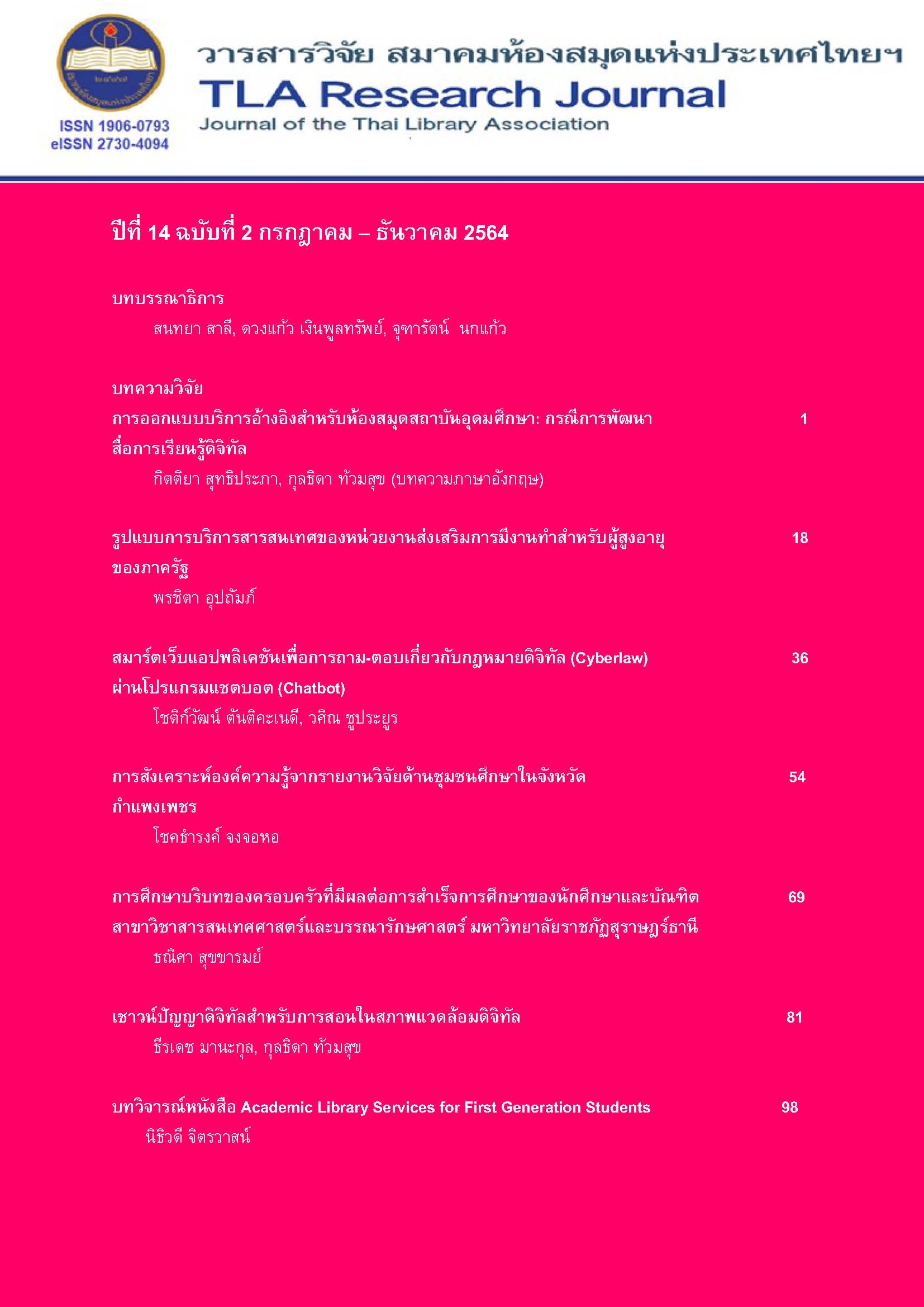Reference Service Design for Academic Library: A Case of Digital Learning Launchpad Development
Main Article Content
Abstract
Reference services in libraries have been changed following users’ needs and advances in information and communication technology (ICT). Thai university libraries have obviously changed as well and developed their innovative reference services due to the influence of advanced ICT. For example, the use of artificial intelligence (AI) technology integrated with a Q&A service via Chatbot, the voice of customers (VoC) system to deal with users’ complaints, clinic-like services to support information resource access and academic development, and information literacy instruction using video clips and online workshop sessions has been implemented. This paper presents the development of reference services by using service design and user experience concepts. The reference service design model for academic libraries was developed by adapting the Double Diamond model (Design Council, 2015) and the TCDC design process (2015) that included three phases, namely, exploration, ideation and creation, and reflection and implementation. Further, a digital learning launchpad (DLL) was developed in the form of a Web application to facilitate graduate students to access and use library resources to support their study and research as they need. The researchers applied the reference service design model for the development of DLL for the university library. The DLL comprised five functions, namely, plagiarism checker, search starter, publication, citation, and copyright. It was found that DLL in the Web application format can effectively facilitate users to learn and get reference services anywhere, anytime. Additionally, they can review their knowledge as soon as they want. This tool enhances autonomous learning and life-long learning skills as well.
Article Details

This work is licensed under a Creative Commons Attribution-NonCommercial-NoDerivatives 4.0 International License.
บทความทุกเรื่องที่ลงตีพิมพ์จะได้รับการตรวจอ่านโดยผู้ทรงคุณวุฒิ ความคิดเห็นและบทความที่ปรากฏในวารสารนี้ เป็นของผู้เขียนซึ่งมิใช่เป็นความคิดเห็นของคณะผู้จัดทำ และมิใช่ความรับผิดชอบของสมาคมห้องสมุดแห่งประเทศไทยฯ การนำบทความในวารสารนี้ไปตีพิมพ์ซ้ำต้องได้รับอนุญาตจากคณะผู้จัดทำ
All articles submitted for publication will be reviewed by the academic reviewers. The editorial board and TLA claim no responsibility for the content or opinions expressed by the authors of individual articles or columns in this journal. Reprinting of any articles in this journal must be permitted by the editorial board.
References
Ahenkorah-Marfo, M. & Akussah, H. (2016). Changing the face of reference and user services: Adoption of social media in top Ghanaian. Reference Services Review, 44(3), 219–236.
Bopp, R.E. & Smith, L.C. (2001). Reference and information services: An introduction. 3rd ed. Libraries Unlimited, Englewood, CO.
Broady-Preston, J. & Felice, J. (2006). Customers, relationships and libraries: University of Malta – A case study. Aslib Proceedings, 58(6), 525–536.
Curtis, D. & Greene, A. (2004). A university-wide, library-based chat service. Reference Services Review, 32(3), 220–233.
De Jong, M. (2014). Service design for libraries: An introduction. In Woodsworth, A. & Penniman, W.D., (Eds.), Advances in Librarianship, Vol. 38, pp. 137–151, Emerald Group Publishing, Bingley, UK.
Design Council. (2015). An introduction to service design and a selection of service design tools. Retrieved from https://www.designcouncil.org.uk/sites/default/files/ asset/document/Design%20methods%20for%20developing%20services.pdf
Ferguson, C. (2000). Shaking the conceptual foundations too: Integrating research and technology support for the next generation of information service. College & Research Libraries, 61(4), 300–311.
Gross, J. & Sheridan, L. (2011). Web-scale discovery: The user experience. New Library World, 112(5/6), 236–247.
James, J. (2002). Digital reference: Reference librarians’ experiences and attitudes. Journal of the American Society for Information Science and Technology, 53(7), 549–566.
Holmlid, S. (2008). Interaction design and service design: Expanding a comparison of design disciplines. The International DMI Education Conference: Design Thinking: New Challenges for Designers, Managers and Organizations, 14–15 April 2008, ESSEC Business School, Cergy-Pointoise, France.
Katz, W.A. (2002). Introduction to reference work, Vol. 1.: Basic information services. 8th ed. McGraw Hill, Boston, MA.
Khon Kaen University Library. (2020). Library service. Retrieved from https://library.kku.ac.th/
Kotler, P. & Armstrong, G. (2008). Principles of marketing. 12th ed. Pearson/Prentice-Hall, Harlow.
Luo, L. (2014). Text a librarian: A look from the user perspective. Reference Services Review, 42(1), 34–51.
Mager, B. (2010). Service design-an emerging field. Retrieved from https://www.academia.edu/20566424/Service_Design_An_Emerging_Field
Mendonca, H. & van Zyl, I. (2014). Youth empowerment: The role of service design and mobile technology in accessing reproductive health information. In Proceedings of the 13th Participatory Design Conference, pp. 103–106, ACM Press, Windhoek.
Moritz, F. (2005). Service design: Practical access to an evolving field. Retrieved from https://www.scribd.com/ document/388256404/MORITZ-Service-design-practical-access-to-an-evolving-field-pdf
Pipatphokakul, P. (2014). Service quality. Retrieved from https://goo.gl/Dt05Hv
Rohrer, C. (2014). When to use which user-experience research methods. Available at https://www.nngroup.com/articles/which-ux-research-methods/
Sadeh, T. (2008). User experience in the library: A case study. New Library World, 109(1/2), 7–24.
Siriprasoetsin, P., Tuamsuk, K., & Vongprasert, C. (2011). Factor affecting customer relationship management practices in Thai academic libraries. International Information & Library Review, 43(4), 221–229.
Stern, C. (2014). CUBI: A user experience model for project success. Retrieved from https://goo.gl/NGFWk1
Stickdorn, M., Schneider, J., Andrews, K. & Lawrence, A. (2011) This is service design thinking: Basics, tools, cases. Wiley, Hoboken.
Suthiprapa, K. & Tuamsuk, K. (2019). Reference services management and innovation in Thai academic libraries: A study based on the market mix 7PS concept. Proceedings of the 2019 International Conference on Library and Information Science (ICLIS), pp. 523–536. 11–13 July 2019, Taiwan National Normal University, Taipei.
TCDC. (2014). Service design. Thailand Creative & Design Center, Bangkok.
TCDC. (2015). Service design process. Retrieved from http://tcdc.groov.asia/method/ assets/PDF/ServiceDesignBook.pdf


